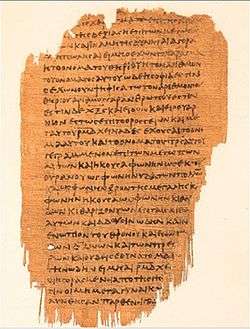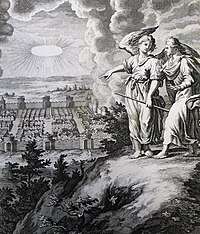Revelation 21
Revelation 21 is the twenty-first chapter of the Book of Revelation or the Apocalypse of John in the New Testament of the Christian Bible. The book is traditionally attributed to John the Apostle,[1][2] but the precise identity of the author remains a point of academic debate.[3] This chapter contains the accounts of "the New Heaven and the New Earth", followed by the appearance of "the New Jerusalem the Bride".[4]
| Revelation 21 | |
|---|---|
 Revelation 13:16-14:4 on Papyrus 47 from the third century. | |
| Book | Book of Revelation |
| Category | Apocalypse |
| Christian Bible part | New Testament |
| Order in the Christian part | 27 |
Text
_-_exterior%2C_cornerstone%2C_Revelation_21-3.jpg)
The original text was written in Koine Greek. This chapter is divided into 27 verses.
Textual witnesses
Some early manuscripts containing the text of this chapter are among others:[5][lower-alpha 1]
- Codex Sinaiticus (330-360)
- Codex Alexandrinus (400-440)
The New Heaven and the New Earth (21:1-4)

Verse 1
- Now I saw a new heaven and a new earth, for the first heaven and the first earth had passed away.
- Also there was no more sea.[7]
Non-conformist minister Alexander Maclaren interprets "a new heaven and a new earth" as meaning "a renovated condition of humanity" and suggests that "and the sea is no more" is "probably ... to be taken in a symbolic sense, as shadowing forth the absence of unruly power, of mysterious and hostile forces, of estranging gulfs of separation". Referring to the island of Patmos where the writer experienced his vision, Maclaren continues, "The sad and solitary and estranging ocean that raged around his little rock sanctuary has passed away for ever".[8]
Verse 2
- Then I, John, saw the holy city, New Jerusalem, coming down out of heaven from God, prepared as a bride adorned for her husband.[9]
The name John appears in the King James Version and New King James Version but is generally omitted in other English translations.[10]
General View of the New Jerusalem (21:9–14)
The beginning part of this section (verses 9–10) forms a parallel with Revelation 17:1-3, which is similar to the parallel between Revelation 19:9-10 and Revelation 22:6-9, indicating a distinct marking of a pair of passages about Babylon and the New Jerusalem (see table below) with Revelation 19:11-21:8 as a transition from the destruction of Babylon to the arrival of the New Jerusalem.[11]
| Revelation 17:1-3 | Revelation 21:9-10(-11a) |
|---|---|
| 1Then one of the seven angels who had the seven bowls came and talked with me, saying to me, "Come, I will show you the judgment of the great harlot who sits on many waters, 2with whom the kings of the earth committed fornication, and the inhabitants of the earth were made drunk with the wine of her fornication."
3So he carried me away in the Spirit into the wilderness. And I saw a woman sitting on a scarlet beast which was full of names of blasphemy, having seven heads and ten horns. |
9Then one of the seven angels who had the seven bowls filled with the seven last plagues came to me and talked with me, saying, "Come, I will show you the bride, the Lamb’s wife."
|
| Revelation 19:9-10 | Revelation 22:6-9 |
| 9Then he said to me, "Write: 'Blessed are those who are called to the marriage supper of the Lamb!'" And he said to me, "These are the true sayings of God." | 6Then he said to me, "These words are faithful and true." And the Lord God of the holy prophets sent His angel to show His servants the things which must shortly take place. 7"Behold, I am coming quickly! Blessed is he who keeps the words of the prophecy of this book." |
| 10And I fell at his feet to worship him.
But he said to me, "See that you do not do that! I am your fellow servant, and of your brethren who have the testimony of Jesus. Worship God! For the testimony of Jesus is the spirit of prophecy." |
8Now I, John, saw and heard these things. And when I heard and saw, I fell down to worship before the feet of the angel who showed me these things.
9Then he said to me, “See that you do not do that. For I am your fellow servant, and of your brethren the prophets, and of those who keep the words of this book. Worship God.” |
Verse 14
- The wall of the city had twelve foundations, and on them were the names of the twelve apostles of the Lamb.[13]
W H Simcox, in the Cambridge Bible for Schools and Colleges, observes that St John the Apostle (if he was the author) "does not notice his own name being written there".[14]
The Walls of the Gates of the New Jerusalem (21:15–21)
The ground plan of the New Jerusalem is shown to be a square (cf. Ezekiel 40:3), '12000 stadia in each direction' (verse 16), but the general form is actually a 'perfect cube', unlike any 'city ever imagined', but 'like the holy of holies' in the Solomon's temple in Jerusalem (1 Kings 6:20), although the New Jerusalem needs no temple (verse 22), because 'the whole city is the holiest place of God's presence'.[15]
The Glory of God in the Temple-City (21:22–27)
The description of the New Jerusalem in many ways is in agreement with the models in the Old Testament and apocryphal literature (Isaiah 52:1; 54:11-12; 60; Ezekiel 40:2-5; 47:1-12; 48:30-34; Zechariah 14:6-21; Tobit 13:16-17), except for the absence of a temple in the new city.[15] The New Jerusalem is called in the Book of Ezekiel as 'The Lord is There' (Ezekiel 48:35) and in the Book of Zechariah the whole city is declared as holy as the temple (Zechariah 14:20-21; cf. Isaiah 52:1).[15]
Verse 27
- But there shall by no means enter it anything that defiles, or causes an abomination or a lie, but only those who are written in the Lamb’s Book of Life.[16]
See also
Notes
- The Book of Revelation is missing from Codex Vaticanus.[6] and this chapter is missing from Codex Ephraemi Rescriptus.
References
- Davids, Peter H (1982). I Howard Marshall and W Ward Gasque (ed.). New International Greek Testament Commentary: The Epistle of James (Repr. ed.). Grand Rapids, Mich.: Eerdmans. ISBN 0802823882.
- Evans, Craig A (2005). Craig A Evans (ed.). Bible Knowledge Background Commentary: John, Hebrews-Revelation. Colorado Springs, Colo.: Victor. ISBN 0781442281.
- F. L. Cross, The Oxford Dictionary of the Christian Church, (New York: Oxford University Press, 1997), 45
- Bauckham 2007, p. 1289.
- Elliott, J. K. "Revelations from the apparatus criticus of the Book of Revelation: How Textual Criticism Can Help Historians." Union Seminary Quarterly Review 63, no. 3-4 (2012): 1-23.
- Claremont Coptic Encyclopaedia, Codex Vaticanus, accessed 29 September 2018
- Revelation 21:1 NKJV
- Maclaren, A., MacLaren: Expositions of Holy Scripture on Revelation 21, accessed 16 December 2018
- Revelation 21:2 NKJV
- BibleGateway.com, Revelation 21:2 in various translations
- Bauckham 2007, pp. 1303–4.
- Based on Bauckham 2007, pp. 1303-1304
- Revelation 21:14 NKJV
- Cambridge Bible for Schools and Colleges on Revelation 21, accessed 17 December 2018
- Bauckham 2007, p. 1304.
- Revelation 21:27 NKJV
Bibliography
- Bauckham, Richard (2007). "81. Revelation". In Barton, John; Muddiman, John (eds.). The Oxford Bible Commentary (first (paperback) ed.). Oxford University Press. pp. 1287–1306. ISBN 978-0199277186. Retrieved February 6, 2019.
![]()
External links
- Revelation 21 King James Bible - Wikisource
- English Translation with Parallel Latin Vulgate
- Online Bible at GospelHall.org (ESV, KJV, Darby, American Standard Version, Bible in Basic English)
- Multiple bible versions at Bible Gateway (NKJV, NIV, NRSV etc.)